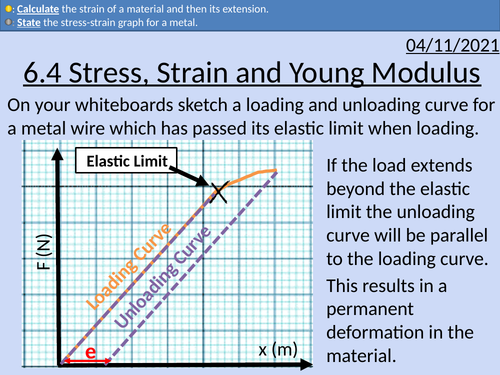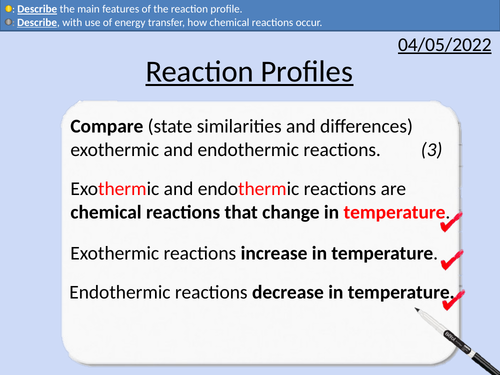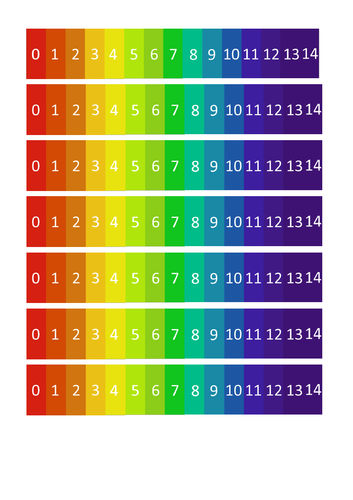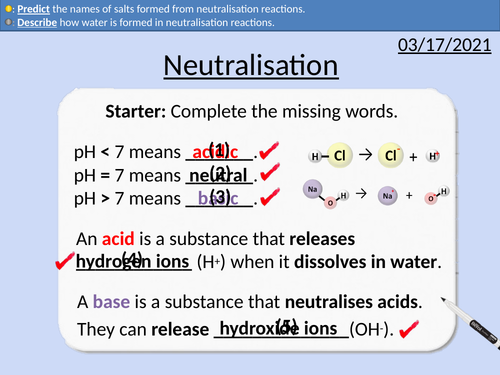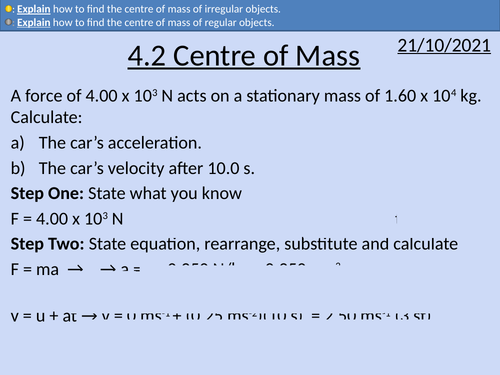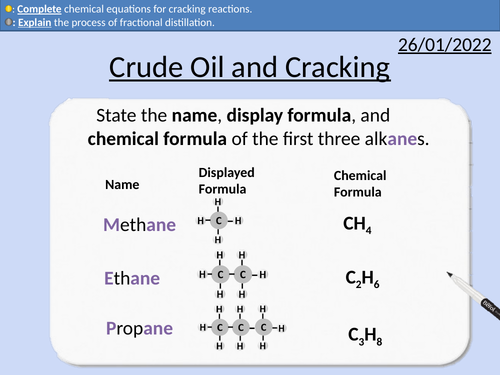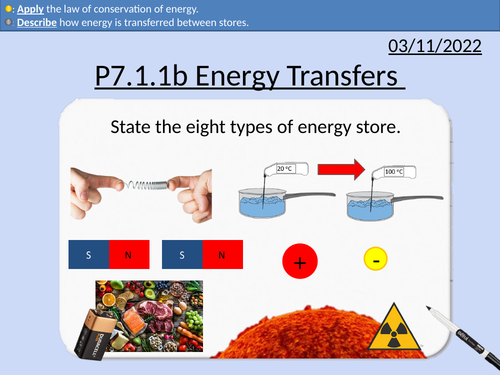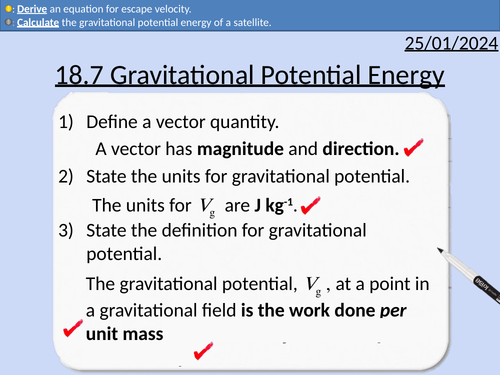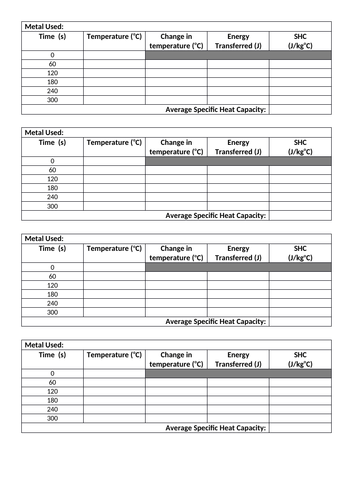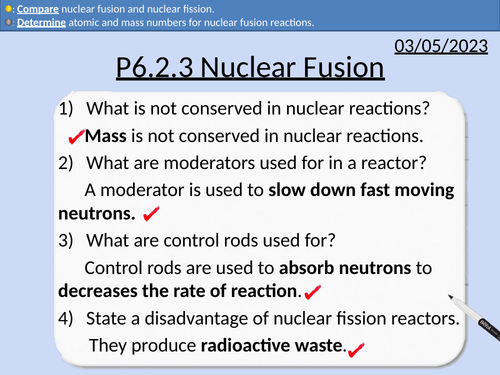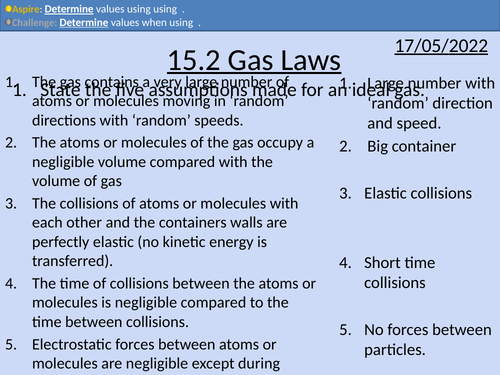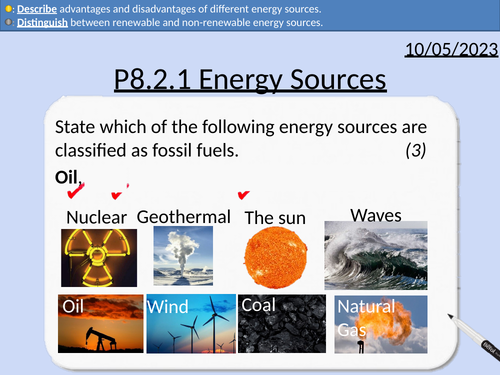497Uploads
169k+Views
72k+Downloads
All resources

OCR AS level Physics: Stress, Strain, &Young Modulus
OCR AS level Physics: Stress, Strain and Young Modulus is a part of the Module 3: Materials. Presentations come with worked examples, solutions and homeworks.
Bundle

GCSE OCR Chemistry C1 Particles
All resources for P1 GCSE OCR Chemistry Gateway 9-1 Triple and combined (Higher and Foundation) is covered in this material.
Includes:
Introducing Particles
Chemical and Physical Changes
Limitations of the Particle Model
Atomic Structure
Isotopes and Ions
Developing the Atomic Model

GCSE Chemistry: Paper Chromatography & Rf Values
This PowerPoint presentation with worked examples and student questions covers:
• Definition of technique for paper chromatography
• Experimental procedure
• Definitions of stationary and mobile phase
• Application of Rf equation with examples and answers

GCSE Chemistry: Thin Layer and Gas Chromatography
This PowerPoint presentation with worked examples and student questions covers:
• Experimental Procedure for Thin Layer Chromatography
• Analysing and calculating Rf Values
• Pros and cons of paper and TL chromatography
• Experimental procedure for Gas Chromatography
• Persuasive writing and embedding literacy in science

GCSE Chemistry: Reaction Profiles
This PowerPoint presentation with worked examples and student questions covers:
• Reaction profiles for exothermic and endothermic
• Energy stores of particles and surroundings
• Activation energy
• Describing the main features of reaction profiles.

GCSE Chemistry: The pH scale
This PowerPoint presentation with worked examples and student questions covers:
• pH 0 - 14 scale with household examples
• Definitions for acids, bases and alkali substances
• Universal indicator and pH probes
• Using equalities and inequalities

GCSE Chemistry: Neutralisation Reactions
This PowerPoint presentation with worked examples and student questions covers:
• Word equations for neutralisation reactions
• Describing how ions form salts
• Describing how water is formed
• Predicting the names of salts formed

OCR AS level Physics: Centre of Mass
OCR AS level Physics: Centre of mass is a part of the Module 3: Force and Motion
Full lesson PowerPoint with worked examples and homework with complete worked answers.

GCSE Chemistry: Alkanes
This PowerPoint presentation with worked examples and student questions covers:
• Definition of hydrocarbons
• Carbon and hydrogen saturation
• Mnemonic device for naming alkanes
• Comparing complete and incomplete combustion
• Balancing complete combustion reactions

GCSE Chemistry: Crude Oil and Cracking
This PowerPoint presentation with worked examples and student questions covers:
• Definition of hydrocarbons
• Fossil fuels being finite and non-renewable
• Inter-molecular forces and boiling points
• Fractional distillation of crude oil
• Uses of crude oil
• Cracking equations and reasons to crack hydrocarbons

GCSE Physics: Types of Waves
This presentation covers OCR Gateway Physics 9-1 P5.1.1a WaTypes of wave. Includes student activities and full worked answers.
Definition of a wave
Mechanical waves
Electromagnetic waves
Transverse waves
Longitudinal waves

OCR AS Chemistry: Alkanes
OCR AS Chemistry: 12.1 Alkanes
This PowerPoint is a whole lessons included with student activities, animated answers, homework questions with answers provided.
This lesson covers:
Sigma bonds (σ-bonds).
Tetrahedral shape and bond angles
Fractional distillation
Chain length and boiling point
Branching and boiling point
London Forces

GCSE Physics: Energy transfers and Conservation of energy
This presentation covers OCR Gateway Physics 9-1 P7.1.1b Energy stores transfers and Conservation of energy.
This PowerPoint covers while including student activities and worked answers:
The law of conservation of energy.
The energy transfer pathways:
Mechanically – with forces
Electrically – with current
Heating by particles
Heating by radiation
Describing stores and transfers for:
Object projected upwards or up a slope,
A moving object hitting an obstacle,
An object being accelerated by a constant force,
A vehicle slowing down,
Bringing water to a boil in an electric kettle

OCR A Level Physics: Gravitational Potential Energy
OCR A level Physics: 18.7 Gravitational Potential Energy
Module 5 Newtonian World and Astrophysics
This PowerPoint is a whole lesson included with student activities, animated answers, homework questions with answers provided.
This lesson covers:
Radial and uniformed field
Definition of gravitational potential energy
Deriving escape velocity
Force-Distance graphs for gravitational fields

GCSE Physics: Specific Heat Capacity Practical
This presentation covers OCR Gateway Physics 9-1 P1.2.3
Presentation includes:
Instructions for experiment
Results table
Rearranging of SHC equation
Exam style question and answer

GCSE Physics: Nuclear Fusion
This presentation covers OCR Gateway Physics 9-1 P6.2.3 Nuclear Fusion
This PowerPoint is a whole lessons included with student activities and animated answers.
Mass and energy equivalence
Nuclear fusion conditions
Fuel for nuclear fusion
Benefits of nuclear fusion
Nuclear equations
Comparing nuclear fusion and fission

OCR A level Physics: Kinetic Theory of Gases
OCR A level Physics: Kinetic Theory of Gases is a part of the Module 5: Newtonian World and Astrophysics. The PowerPoint presentation includes worked examples, solutions and a homework.

OCR A Level Physics: Analysing Simple Harmonic Motion
OCR A Level Physics: Analysing Simple Harmonic Motion presentation with homework and answers.

OCR A level Physics: Gas Laws
OCR A level Physics: Gas Laws is a part of the Module 5: Newtonian World and Astrophysics. The PowerPoint presentation includes worked examples, solutions and a homework.

GCSE Physics: Energy Sources
This presentation covers OCR Gateway Physics 9-1 P8.2.1 Energy Sources
This PowerPoint is a whole lessons included with student activities and animated answers.
Types of different energy sources
Renewable and non-renewable definitions
Different uses of energy sources - transport, heating, and generating electricity
Advantages and disadvantages of different energy sources
Fossil fuels – oil, coal, and natural gas.
Nuclear fuel – Uranium
Biofuels – wood, biodiesel, and biogas.
The sun - solar (PV) panels and solar heating panels
Tides,
Waves,
Hydroelectricity
Wind
Geothermal

